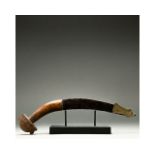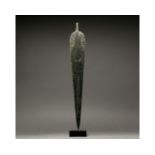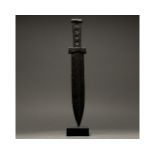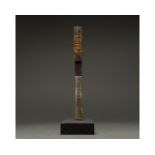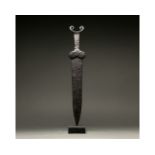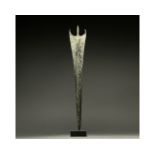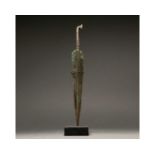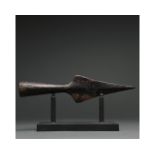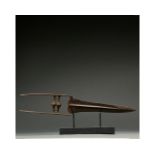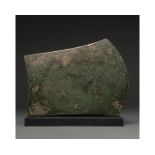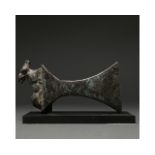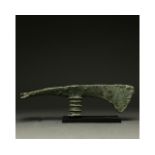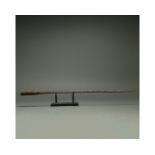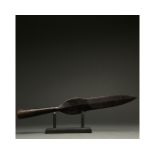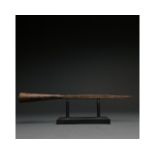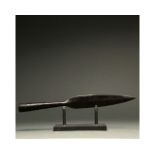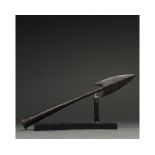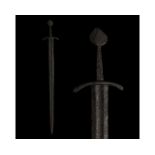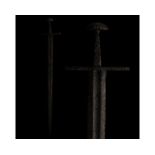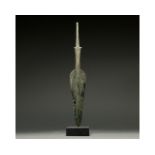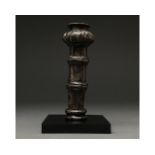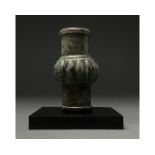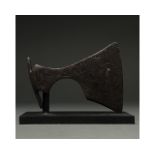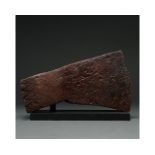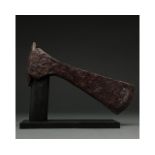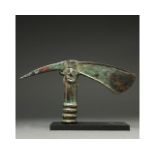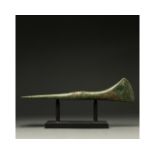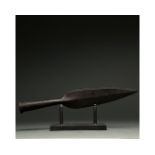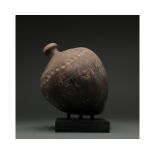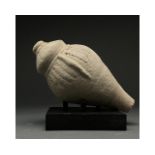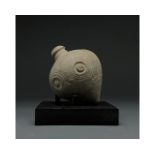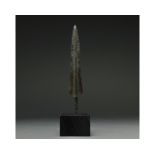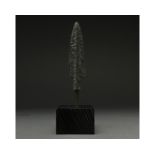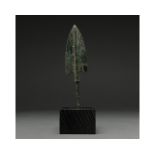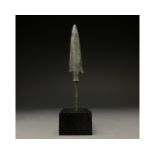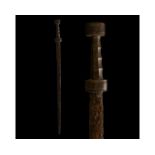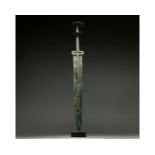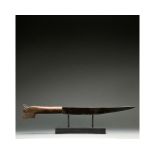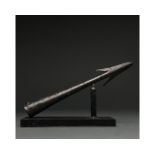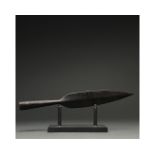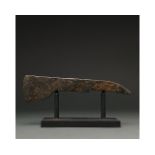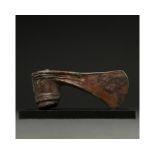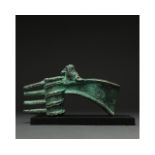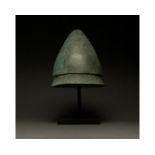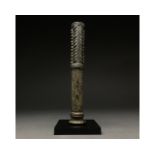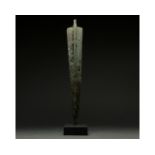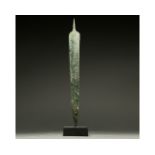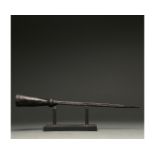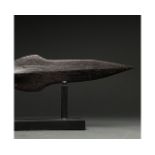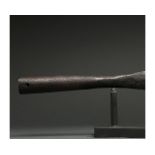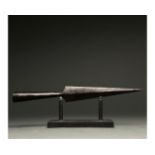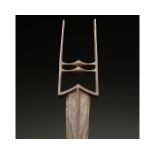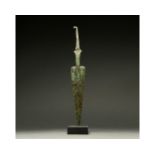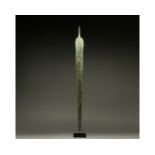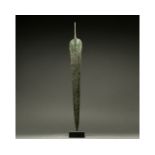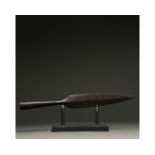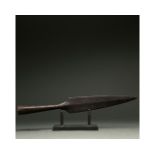Refine your search
Estimate
Category
- Arms, Armour & Militaria (180)
- Jewellery (118)
- Greek, Roman, Egyptian & Other Antiquities (86)
- Chinese Works of Art (55)
- Scientific Instruments (33)
- Sculpture (24)
- Collectables (20)
- Coins (19)
- Ceramics (13)
- Salvage & Architectural Antiques (8)
- Vintage Fashion (8)
- Glassware (7)
- Bank notes (6)
- Islamic Works of Art (6)
- Metalware (6)
- Books & Periodicals (5)
- Models, Toys, Dolls & Games (3)
- Textiles (3)
- Classic Cars, Motorcycles & Automobilia (2)
- Musical Instruments & Memorabilia (2)
- Wines & Spirits (2)
- Clocks (1)
- Kitchenalia (1)
- Silver & Silver-plated items (1)
Filtered by:
- Item Type
- List
- Grid
A subscription to the Price Guide is required to view results for auctions ten days or older. Click here for more information
C. 900 AD. Viking age. A medieval Scandinavian pointed knife with a curved blade; expertly cleaned and conserved with a hand-carved, reconstructed...
1200-700 BC, Greek Archaic Period. This beautiful cast bronze sword has a tapering, bevelled blade adornned with a deep fuller or "blood groove" w...
c. 323-31 BC. Greek Hellenistic period - Sythian.This beautiful iron sword / acinaces has a tapering, bevelled blade with a raised midrib, a simpl...
C. 900 AD. Viking age. A medieval Scandinavian pointed knife with tapering blade and original bone handle comprising a cylinder of bone decorated ...
c. 323-31 BC. Greek Hellenistic period.This beautiful iron sword has a tapering, bevelled blade with an inverted hear-shaped guard and an integral...
1200 – 800 BC, Greek Archaic. An ancient Greek era cast "Trojan" Bronze Age sword blade with a narrow, triangular blade; raised midrib; with sha...
1200-700 BC, Greek Archaic Period. This beautiful cast bronze sword has a tapering, bevelled blade with a raised midrib and a robust, laterally an...
CRUSADERS PERIOD IRON SPEAR HEAD
1000-1500 AD, Crusader Period. An iron spearhead comprising a squat tapering triangular blade witha short neck and a long socket for increased con...
MUGHAL IRON KATAR DAGGER
C. 1600 – 1800 AD. Post-medieval. An iron Katar dagger or knuckleduster comprising a two-part, bulging grip with guard and leaf-shaped blade wit...
ca. 2000-1500 BC. Early Bronze Age. A large bronze flat axe with a curved blade and wedge-shaped cheek. Bronze weaponry production flourished from...
c. 2000-1000 BC, Amlash culture. A rare bronze age axe head with straight blade, wedge-shaped cheek, reinforced, round socket and flanged butt fea...
C. 2000-700 BC. Luristan culture. A huge bronze battle axe with a short, downward angled blade, wedge-shaped cheek, and hammerhead butt, allowing ...
C. 100-300 AD. Roman. A large socketed iron pilum spear head with a pyramidal blade and twisted neck. Pila were a key part of Roman military equip...
C. 100-300 AD. Roman. A large iron pilum spear head with a pyramidal blade and robust, flaring socket. Pila were a key part of Roman military equi...
VIKING AGE IRON SOCKETED SPEAR
C.800-1110. Viking Age. Iron spearhead with lanceolate blade with flaring shoulders and a circular socket. Spears were an important component of V...
VIKING AGE IRON SOCKETED SPEAR
C.800-1110. Viking Age. Iron spearhead with pyramidal blade and a gently flaring circular socket. Spears were an important component of Viking mil...
C. 300-500 AD Roman. An iron spearhead comprising a tapering leaf-shaped blade with a slightly raised midrib and a long socket for increased contr...
ROMAN IRON PILUM SPEAR
C. 100-300 AD. Roman. An iron pilum spear head with a barbed, triangular blade, and a long, narrow neck, and a robust flaring socket. Pila were a ...
VIKING IRON SWORD WITH HANDLE
900-1100 AD. Viking age. An iron sword with a long, doubled-edged blade, with a deep fuller or "blood-groobe" culminating in a point, a simple lun...
VIKING IRON SWORD WITH HANDLE
700-1000 AD. Viking age. An iron sword with a long, doubled-edged blade, culminating in a point with a wide, rectangular guard and hemi-spherical ...
1200-700 BC, Greek Archaic Period. A bronze spearhead with a triangular, lentoid-sectioned blad with a raised midrib, short neck and tang. Bronze ...
BRONZE AGE DECORATED MACE HEAD
C. 2000-700BC, Luristan culture. A Luristan cast bronze mace head with a tubular shape and a protruding, compressed spheroid midsection. The upper...
BRONZE AGE DECORATED MACE HEAD
C. 2000-700BC, Luristan culture. A Luristan cast bronze mace head with a tubular shape and a protruding, compressed spheroid midsection with raise...
c. 900-1100 AD. Viking age. An iron bearded axe head with a heavy, curved blade, narrow cheek, rounded socket and rectangular flanges. The bearded...
VIKING IRON DECORATED BATTLE AXE
c. 900-1100 AD. Viking age. An iron axe head comprising a wedge-shaped blade, tapering cheek, reinforced poll and rounded socket. The cheek and po...
VIKING IRON BATTLE AXE HEAD
c. 900-1100 AD. Viking age. An iron axe head comprising a short, curved blade, elongated cheek, lozenge-shaped poll and rounded socket. The era kn...
c. 2000-1000 BC, Amlash culture. A rare bronze age axe head with short, curved blade, arching cheek, round socket, elongated shoulder and spiked b...
C. 2000-700 BC. Luristan culture. A huge bronze battle axe with a short, upward angled, slightly curved blade, wedge-shaped cheek, slightly bulgin...
C. 300-500 AD Roman. An iron spearhead comprising a tapering leaf-shaped blade with a slightly raised midrib and a long socket for increased contr...
900-1200 AD, Byzantine. Decorated Byzantine "fire grenade" comprising a globular brown vessel with a short neck, flaring shoulders decorated with ...
900-1200 AD, Byzantine. Decorated Byzantine "fire grenade" comprising a globular greyish vessel with a short, conical neck which restricts before ...
900-1200 AD, Byzantine. Decorated Byzantine "fire grenade" comprising a globular greyish vessel with a short neck, flaring shoulders decorated wit...
1200-700 BC, Greek Archaic Period. A squat bronze spearhead with a flaring leaf-shaped, lentoid-sectioned blade, raised midrib with a short tang. ...
1200-700 BC, Greek Archaic Period. A bronze spearhead with a triangular, lentoid-sectioned blade with a raised midrib, short neck and tang. Bronze...
1200-700 BC, Greek Archaic Period. A squat bronze spearhead with an slightly barbed leaf-shaped, lentoid-sectioned blade, raised midrib with a sho...
1200-700 BC, Greek Archaic Period. A bronze spearhead with a barbed, triangular, lentoid-sectioned blade with a raised midrib, short neck and long...
C. 100-500 AD. Roman. An iron spatha with a long tapering, bevelled blade and a beautiful handle with two rectangular termini between which is a l...
1200-700 BC This beautiful cast bronze sword has a tapering, bevelled blade with a raised midrib and beautiful integral handle comprised of long c...
C. 900 AD. Viking age. A medieval Scandinavian pointed knife with a slightly curved blade; expertly cleaned and conserved with a hand-carved, reco...
c. 323-31 BC. Greek Hellenistic period.This beautiful iron sword has a tapering, bevelled blade with a raised midrib, a simple guard and a ribbed ...
ROMAN IRON PILUM SPEAR
C. 100-300 AD. Roman. An iron pilum spear head with a barbed, triangular blade, and a long, narrow neck, and a robust flaring socket. Pila were a ...
C. 300-500 AD Roman. An iron spearhead comprising a tapering leaf-shaped blade with a raised midrib and a long socket for increased control. Weapo...
MEDIEVAL IRON SPIKED AXE
1100-1300 AD. Medieval. Iron axe with short, curved blade, full cheek, elliptical socket and spiked butt for delivering a secondary, armour penetr...
c. 900-1100 AD. Viking age. An iron bearded axe head with a heavy blade, narrow cheek, rounded socket and rectangular flanges. The bearded axe, or...
C. 2000-700 BC. Amlash culture. A bronze battle axe with a curved blade, tapering cheek, reinforced haft and circular socket. The upper and lower ...
C. 2000-700 BC, Luristan culture. A Luristan axe head with a short, curved, downwards facing blade, arched cheek, reinforced rounded poll with fou...
c. 450 - 350 BC Etruscan. A rare Etruscan bronze helmet of Negau type comprising a truncated conical helmet with a thin, instepped, slightly flari...
2000-700 BC, Luristan culture. A cast bronze mace head with a tubular shape. The mace head is decorated with 12 rows of raised chevrons framed abo...
ANCIENT BRONZE SWORD ON STAND
1200-700 BC, Greek Archaic Period. This beautiful cast bronze sword has a tapering, bevelled blade with a raised midrib and a flat tang. Bronze we...
ANCIENT BRONZE SWORD ON STAND
1200-700 BC, Greek Archaic Period. This beautiful cast bronze sword has a tapering, bevelled blade with a raised midrib and a flat tang. Bronze we...
VIKING ERA IRON SOCKETED SPEAR
C.800-1110. Viking Age. Iron spearhead with pyramidal blade with which transitions into a spherical neck, and a long, circular socket. Spears were...
VIKING ERA IRON SOCKETED SPEAR
C.800-1110. Viking Age. Iron spearhead with lanceolate blade with flaring shoulders and a long, circular socket. Spears were an important componen...
ROMAN IRON SOCKETED SPEAR HEAD
C. 300-500 AD Roman. An iron spearhead comprising a slender tapering blade and a long socket for increased control. The socket also has a centeral...
ROMAN IRON SOCKETED SPEAR HEAD
C. 300-500 AD Roman. An iron spearhead comprising a tapering triangular blade with a raised midrib and a long socket for increased control. Weapon...
MUGHAL IRON KATAR DAGGER
C. 1600 – 1800 AD. Post-medieval. An iron Katar dagger or knuckleduster comprising a two-part, bulging grip with guard and leaf-shaped blade wit...
LARGE BRONZE AGE SPEAR ON STAND
1200-700 BC, Greek Archaic Period. Bronze Age. A bronze spearhead with a leaf-shaped, lentoid sectioned blade, a wide raised midrib and a flaring ...
1200-700 BC, Greek Archaic Period. This beautiful cast bronze sword has a tapering, bevelled blade with a raised midrib and a flat tang. Bronze we...
1200-700 BC, Greek Archaic Period. This beautiful cast bronze sword has a tapering, bevelled blade with a raised midrib framed by delicate raised ...
C. 300-500 AD Roman. An iron spearhead comprising a slender tapering leaf-shaped blade with a raised midrib and a long socket for increased contro...
C. 300-500 AD Roman. An iron spearhead comprising a slender tapering leaf-shaped blade with a raised midrib and a long socket for increased contro...

